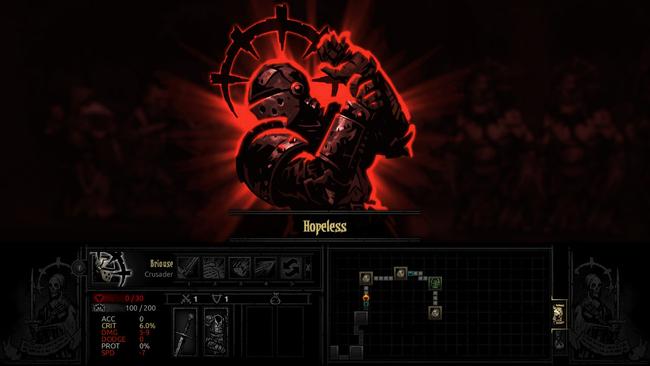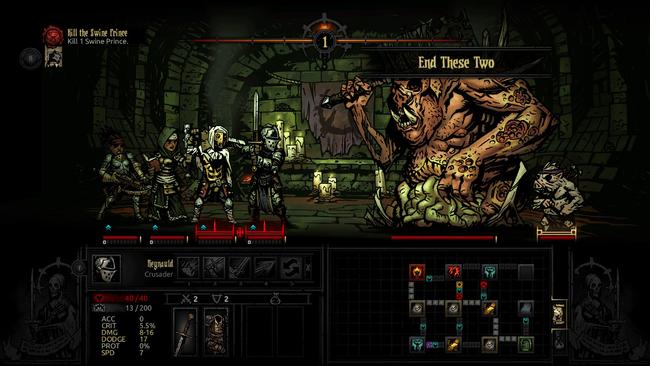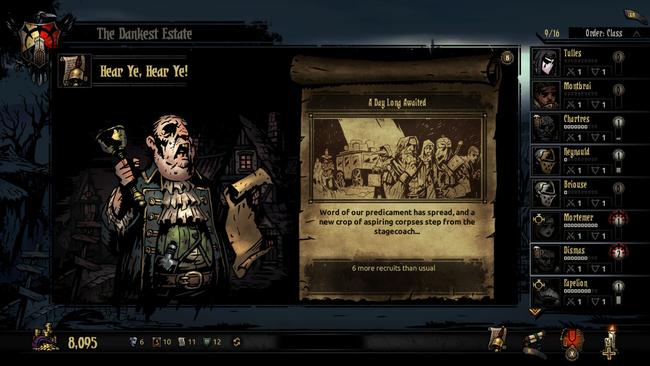Darkest Dungeon Review
I’m out of torches, and the dungeon is getting dark. I only have two rooms left to explore, but I have no clue what’s ahead. My party is hurt and stressed out, with my Highwayman slinging insults at my party as a result of the intense stress he’s under, in turn putting pressure on the other party members and making them perform less adequately in fights. My Arbelist almost died earlier in the run, and an unlucky hit can easily kill her, who also happens to be my best character. I could retreat with this bag full of loot, but a mission failure will only stress out my characters more, and leave them unusable for a week or two as they recover from their dungeon delve. So what do I do? Push forward and risk the physical and mental health of my characters, or retreat and take the failure and the consequences of that?

Darkest Dungeon, first and foremost, is a game about management and difficult decisions. You have to pick your four-man spelunking party with care and make sure to take enough supplies to last the entire trip, even if that means you can’t carry as much loot back. You have to intimately understand each of the areas, with the enemies you’ll fight and the obstacles you’ll come across, and prepare accordingly. For example, there’s not much of a use for skills that inflict bleeding if you’re fighting mostly undead enemies, but if you’re in an area with mostly human enemies, then bleeding and causing blight can be the difference between a successful battle and a grueling one.
In terms of combat, Darkest Dungeon is a turn-based RPG, with turn order determined by character speed. Allies and enemies are lined up on a 2D field, and positioning is very important. Ranged and melee skills can only be used from certain positions, and your positioning getting mixed up as a result of skills or whatever else can mess up your ability to do damage and heal. Additionally, when most enemies are killed they’ll leave behind corpses, which are nothing more than obstacles in the way of other enemies. They have to be cleared out if melee characters can’t reach the enemies in the back, by way of skills or simply hacking at the corpses until they’re gone. Stress-inducing foes tend to be placed farthest back as well, so it’s important to try to kill them quickly.

Battles can be stressful (for the player as well as the heroes in the game), but since they are turn-based, you can take as much time as you need to figure out your next move. It’s important to take note of the skills you have at your disposal, as well as how likely you can kill an enemy quickly, which of course makes mitigating damage easier to handle. Once you learn what each character class has to offer and figure out what their strengths are, you’ll find battles very satisfying, if still nerve-wracking at times.
You also have to take care to manage the Hamlet, the general hub of the game. In the Hamlet, you can grab new ‘aspiring corpses’, de-stress your heroes, level up their equipment and skills, and more. But, in order to fully take advantage of these places, you need to level them up with heirlooms. Heirlooms are received as both quest rewards and in the dungeons themselves, and are of the utmost importance, possibly even moreso than gold itself. What kind of buildings you want to level up will also help you decide which quests to take. For example, if you want Deeds and Crests to level up the Guild, then you would want to take a quest with one of those two heirlooms as a reward. You can trade in some heirlooms in for others, but it really isn’t worth it until you get to the point that most buildings are maxed out and you’re just trying to finish up the remaining areas.

All of this comes with a tough initial learning curve, that can be frustrating at times. While you’re trying out new classes, and getting a feel for each of the areas, you WILL fail missions, and you WILL have characters permanently die. Darkest Dungeon is not a game to pull its punches, and it is not afraid to punish you for a lack of knowledge, even on the Radiant mode that is recommended for first time players. While there are some tutorials available, but you’ll have to figure out the ins and outs of the dungeons on your own to increase your chances of survival. Well, that or read up some beginner’s guides to get your bearings, but the information is there to glean in the game if you’re willing to pay attention and take risks.
However, you can really be at the mercy of RNG, and while Darkest Dungeon is usually tough but fair, a few unfortunate RNG rolls can ruin even the best-prepared runs. I’ve had dungeon runs where a character gets so stressed out they’ll suffer an affliction (which has a plethora of negative effects) in the first battle, or a bad streak of missed attacks couple with enemy criticals wearing my team down in what shouldn’t be a difficult run. While it does feel like the game and your management skills really shine when you’re put into unexpected and difficult situations, at times these challenges can feel a bit unnatural and manufactured. Generally, Darkest Dungeon doesn’t feel that way (even if all of these situations are a result of RNG and randomization), but there are times the game just seems to throw you into dangerous situations only to remind you that this is, in fact, supposed to be hard.

Despite the difficulty and occasional frustration, though, I cannot get enough of Darkest Dungeon. It’s addicting to methodically plan out your party and what quest you’re taking, to succeed by the skin of your teeth, and to try again. Playing Darkest Dungeon on the Switch makes it even more addicting, as the ability to move between handheld and TV modes is fantastic for a title like this. Additionally, the handheld mode takes advantage of the touch controls. Darkest Dungeon was originally a PC title, and the gamepad controls can feel a little unwieldy until you get the hang of it—but with the Switch, you can switch between traditional controls and touch controls seamlessly, making it easy to disarm traps without accidentally stepping on it, among other tasks.
I’m not the biggest fan of games that punish you for the smallest mistake, but in spite of that, I really enjoyed my time with Darkest Dungeon. The game rarely feels unfair, and proper preparations and knowledge of what you’re getting into will generally get you through to the end safely. While the loop of entering dungeons and slowly building up resources and character levels might seem repetitive on paper, it’s really more addicting, as you eventually gain parties strong enough to defeat bosses and delve into the Darkest Dungeon itself. Its addition to the Switch library is a great boon, and I highly recommend it there—however, this difficult RPG is worth the price of admission on any platform.